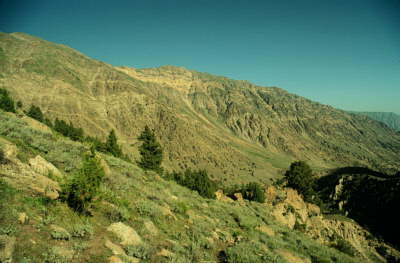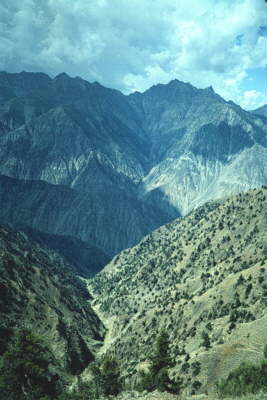
Geology of the southwestern margin of the Nanga Parbat Massif

Indian Cover Sequence
In the area that is encompassed by the N-S trending Bunar valley, and NW trending Diamir valley, the main fabrics trend N to NNE (Fig. 2a). In this area, the Indian cover passive margin rocks that form the original MMT footwall include sequences of carbonates and amphibolites (Permian "Panjal Traps") interlayered with metapelites. In Diamir Valley, these are not more than a few 100's metres thick. Here, the regionally NW-dipping cover sequences and MMT hanging wall (Kamila amphibolite) are overturned (SE-dipping). These overturned layers are traceable to a recumbent open fold (the Gashit fold) in Airl Gah near the village of Gashit, where they form the upper (overturned) limb (Fig. 3). The hinge line and axial plane of the fold plunge gently N. South of this fold, the lower limb dominates the present erosion level, and sequences are not overturned and dip moderately to steeply west. The thickness of the cover sequence increases markedly to the south; carbonates, amphibolites and metapelites of at least 5 km structural thickness are present in the W-E Airl-Nashkin section, 8 km to the south of Diamir valley. This abrupt change in cover sequence thickness is too large to be original depositional variation. Possible tectonic interpretations are given in the discussion.

Diamir - Airl Gah - Jalhari Shear Zone
Structurally lower in the MMT footwall, and to the east (Fig. 2a, Fig. 3), the cover sequence passes into a dominantly plutonic, 5 km thick crystalline sequence that forms a continuous ~N-S belt, that is vertical to steeply E-dipping. The Diamir and Airl Gah valleys offer sections through the belt with almost continuous outcrop. From these valleys, it is clear that coarse to fine grained biotite granite (the Jalhari granite) grades into granitic and porphyroclastic gneiss due to syn- to post-plutonism deformation. This is recognised by the relationship between the levels of deformation in the granite-gneiss. Jalhari leucogranite lenses (10’s - 100’s m thick) show little to no sub-solidus deformation. These lenses are separated by 10’s - 100’s m thick layers of gneiss where deformation of the granite has been localised. These higher strain layers are anastamosed around the granite lenses, and define reverse faults that “climb” to the west. The granitic gneiss shows dominantly sub-solidus strain, including S-C porphyroclastic fabric whose sense of shear consistently indicates east side (NPHM) up and over west. Well-developed shear bands, and narrow fault gouge horizons are also found. These are steeply E-dipping and parallel to sub-parallel with the gneissic layers. Late strain is often indicated by narrow (metres) zones where hydrothermal flux has developed thick biotite accumulations. Asymmetric folding (cm-wavelength) of the biotite foliation also indicates east side up and over west. Farther south in Biji Gah, near Garol, leucogranite layers within metasedimentary mylonites near the western margin of this shear zone are spectacularly and syn-kinematically deformed, and deformed veins in the metapelites also demonstrate east-side-up shear sense. Overall the granite gneiss belt defines a steep N-S trending, W-vergent, reverse sense shear zone 5 km in width. The E over W sense is consistent with the development of the Gashit fold and the upper limb that includes the overturned cover/MMT layers. This shear zone forms the mechanical continuation of the Raikhot Fault (a NW-vergent reverse fault with NPHM in the hanging wall). The Raikhot Fault is much narrower (<<5 km) however, and represents more focused strain. We interpret the emplacement of the Jalhari granite to be at least partly syn-kinematic.
Some Geochronology
Th-Pb ion microprobe measurements on monazite grains separated from low-strain portions of the Jalhari granite in the Diamir Valley gave ages of 3-9 Ma. Monazite grains from similarly unstrained portions of a leucogranite, which we think is related to the Jalhari granite, at Garol (20 km to the south of Diamiri) give a Th-Pb age of 12 Ma. Based upon the textural equilibrium of the granites, and based upon monazite saturation temperatures of High Himalayan leucogranites (e.g. Montel, 1993; Harrison et al., 1995), we interpret these as crystallisation ages. Some might interpret these as metamorphic monazite ages, but there is no evidence that the surrounding rocks in the Diamir/Airl region ever attained granulite facies.